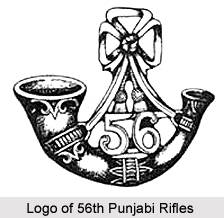 The 2nd Regiment of Punjab Infantry, also known as the 56th Punjabi Rifles (Frontier Force) unit, was a British Indian infantry regiment. It was one of the most prestigious battalions of the British Indian Army. The regiment was raised by British East India Company in 1849. Later in 1906, the military battalion was re-designated as the 56th Punjabi Rifles (Frontier Force). The army regiment was eventually renamed as the 2nd Battalion 13th Frontier Force Rifles in 1922.
The 2nd Regiment of Punjab Infantry, also known as the 56th Punjabi Rifles (Frontier Force) unit, was a British Indian infantry regiment. It was one of the most prestigious battalions of the British Indian Army. The regiment was raised by British East India Company in 1849. Later in 1906, the military battalion was re-designated as the 56th Punjabi Rifles (Frontier Force). The army regiment was eventually renamed as the 2nd Battalion 13th Frontier Force Rifles in 1922.
History of 2nd Regiment of Punjab Infantry
The 2nd Regiment of Punjab Infantry was formed as part of the Trans-frontier Brigade by Lieutenant J. C. Johnston on 18 May 1849 at Mianwali. Later in the year 1851, the regiment became part of the Punjab Irregular Force, which was later celebrated as The Piffers or the Punjab Frontier Force. The Piffers included 11 regiments of infantry, 5 regiments of cavalry and 5 batteries of artillery, along with the Corps of Guides. Their primary function was to sustain order in the Punjab Frontier. The 56th Punjabi Rifles participated in several frontier military operations. The troops remained loyal to the British administration during the Sepoy Mutiny in 1857 and took part in various important missions.
Military Operations of 2nd Regiment of Punjab Infantry
The 2nd Regiment of Punjab Infantry also participated in the Siege of Delhi, the Battle of Cawnpore, the Siege of Lucknow and the Capture of Lucknow, the seize of Bareilly and the Rohilkhand Campaign. The military unit also served in the Battle of Peiwar Kotal during the Second Anglo Afghan War from 1878 to 1880. In the year 1897, the brigade provided service in the Tirah Campaign. After the Kitchener reforms in the British Indian Army in 1903, the unit was renamed as the 56th Infantry (Frontier Force). The class composition of the regiment was two companies of Dogras, two companies of Pathans, two companies of Sikhs, and two companies of Punjabi Muslims in 1914.
The troops served during the First World War as a part of the 28th Frontier Force Brigade. The regiment also fought in Aden (Yemen) and Egypt in 1915. The unit was later stationed in Mesopotamia and participated in the operations for the Relief of Kut al Amara on the Tigris Front from the year 1916 to 1917. It also served in Baghdad, Tikrit, Daur and Istabulat. The 56th Punjabi Rifles (Frontier Force) was stationed in Palestine in 1918 and fought in the Battle of Megiddo. The troops went back to British India in 1920. A 2nd battalion of the 2nd Regiment of Punjab Infantry was formed in 1917. It fought in the Third Anglo Afghan War in 1919.
Development of 2nd Regiment of Punjab Infantry
In 1922, the 1st Battalion and the 2nd Battalion of the 2nd Regiment of Punjab Infantry were merged with the 55th Coke`s Rifles (Frontier Force), 57th Wilde`s Rifles (Frontier Force), 58th Vaughan`s Rifles (Frontier Force)and 59th Scinde Rifles (Frontier Force) to raise the 13th Frontier Force Rifles. The 1st Battalion, 56th Punjabi Rifles was designated as the 2nd Battlaion, 13th Frontier Force Rifles and the 2nd Battalion 56th Punjabi Rifles was named as the 10th (Training) Battlaion.
Designations of 2nd Regiment of Punjab Infantry
The 2nd Regiment of Punjab Infantry of the British Indian Army held several titles throughout the re-organizations of the Indian army. These are listed as follows -
* 2nd Regiment of Punjab Infantry in 1849
* 56th Infantry (Frontier Force) in 1905
* 2nd Regiment of Infantry, Punjab Irregular Force in 1851
* 2nd Regiment of Infantry, Punjab Frontier Force in 1865
* 2nd Punjab Infantry in 1901
* 56th Infantry (Frontier Force) in 1903
* 56th Punjabi Rifles (Frontier Force) in 1906
* 1st Battalion 56th Punjabi Rifles (Frontier Force) in 1917
* 2nd Battalion 13th Frontier Force Rifles in 1922
* 2nd Battalion, The Frontier Force Rifles in 1945






































